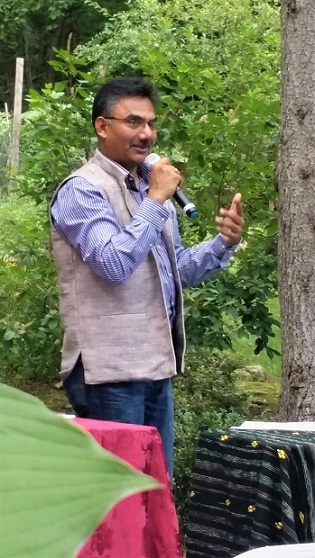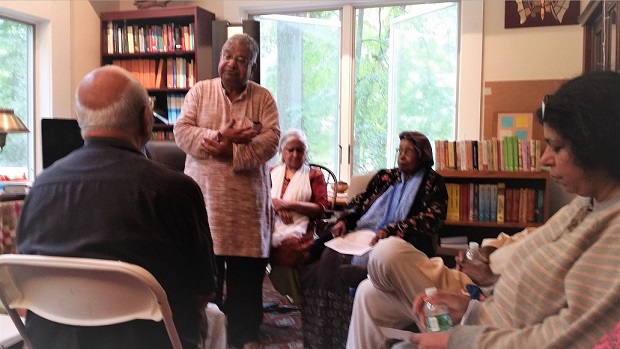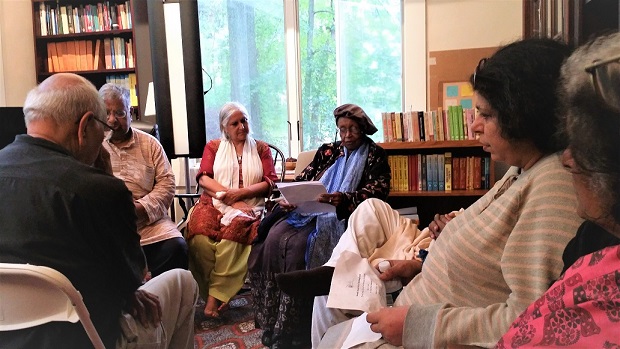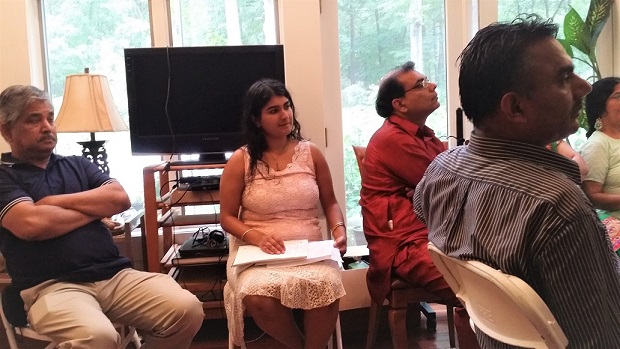Contribute
| SAPNE South Asian Folk And Oral Literature Festival |
Srabonti Bandyopadhyay and Neena Wahi
08/30/2018
Indian culture lives among
people. The vast regions of South Asia are the home of world’s oldest
mythology, folklore, ballads and rhythm of life. Rhythm becomes our
company in life, we perform our best when we are in rhythm. Rhythm is
harmony in human existence and it manifests in human expressions. Without
fully analyzing it, we settle it as an inner voice and then we use the term
“Godâ€. On the summer Saturday afternoon of
August 18, 2018, under the cloudy skies reminiscent of the romantic monsoons of
India, members of South Asian Poets of New England (SAPNE) assembled in the
backyard at 180 Bedford Road in Lincoln, MA, to celebrate oral and folk
literature of South Asia. It was a
village setting of a garden. The meeting was divided into two sessions with a
delicious potluck lunch awaiting the poets. Fifteen poets participated, many
who had come with their significant others.
Mrs. Ruth Hill, the octogenarian oral historian at Harvard University
joined as the Guest of Honor. Ruth and
her late husband Dr. Hugh Hill have been long-time supporters and participants
in the South Asian poetry events. Dr. Bijoy Misra started the program
by introducing the topic of the day by stressing that the folklore is the
rendering of our inner voice which is shared by the rest of the community. A lore is spontaneous, natural and
meaningful. He then invited the poets to recite their
poetry and to wrap it up with voice rendering. The first session aptly began
with a passionate and beautiful tribute to late Atal Bihari Vajpayee by Mr. Sanjeev
Tripathi. His poem in Hindi described the late Prime Minister of India as the
rarest of rare jewels, leaving behind a legacy tall in stature and length. He
then recited another poem from Madhya Pradesh that praised the medieval king,
Raja Chhatrasal. This showed a
different aspect of folk poetry where emotional motivation is achieved through
jingoism and superlative narration. As the next poet just began her beautiful song, the rain
gods came calling and we ventured inside.
We continued the program in the library of the house. An exponent of
Hindustani classical music, Ms. Madhu Mathur Anand sang in her mellifluous
voice, extolling the internal beauty and how the internal beauty is but a
reflection of the beauty and love pervading the universe. The language was a
combination of Hindi and Urdu. This was followed by an incisive analysis of the importance
of oral and folk literature by Mrs. Ruth Hill. In indigenous cultures, oral history defines
the cultural tradition and the social conduct.
During the period of American slavery, oral literature kept the link
between the old culture and the new society.
Most of the African culture in the US is retained through oral history
and literature. Oral literature
represents the voice of the people. Ms. Neena Wahi recited a poem in Hindi titled, Mere
Veera No Aalen de Babool, Doli rok lo kaharon ek din hor. The poem is based
on a folk song and is about a girl who leaves her childhood home due to
marriage. She pleads with her father to let her stay one more night, while she
reminisces her childhood days with her brother. Ms. Geetha Patil followed with a sweet Kannada
poem, Nimbiya Banada Myagala, a folk song or Janapada Geethe, sung by
villagers at the time of cleaning their farm land or grains. The song is a prayer to Gods and Goddesses
for their blessings. It thanks them for
the bounties of life. After Geetha’s poem, the attendees broke for lunch,
which was a gastronomical treat of Indian delicacies like Sarson ka saag with
Makai ki roti, aloo matar, sabzi and curd rice, ably supported by a plethora of
desserts like Chocolate Cake, Moong Dal Halwa and Apple Pie along with sweet
mangoes. The session
resumed with Ms. Srabonti Bandyopadhyay singing two songs by Shri Rabindranath
Tagore, Hridoye Mondrilo Domoru Guru and Mono moro meghero shonghi.
Both songs reflected on the beautiful yet awesome monsoons. Dr. Mir Fazlul Karim followed with two Bengali
poems Amar Chotto Gram and Amar Shob Din Ratri. The first poem
narrated the rustic village life while the latter joked how social media has pervaded
the personal space. Mr. Jayant Dave recited a beautiful Gujarati folk song, Chando
Obhiyo Abhama. The song is
usually accompanied by the folk Dandiya dance. The villagers get ecstatic to
see the moon while the night appears like a beautiful bride with a star-studded
saree to entice the moon. The moon’s light
makes everything beautiful. This was followed by a love poem in Kannada by Dr. R.
Balachandra. A young girl describes the
boy she falls in love with and how she becomes his bride. The girl loves the boy, but the boy is
reticent. We were then treated to a pair
of delectable Ghazal and Sufi songs in the melodious voice of Mr. Nadeem Mirza
of Pakistan. Urdu literature and
rendering build on the tonal quality of the human voice and produce the subtle
difference in meaning through intensity and stress. Mr. Mirza played harmonium in his singing. With the rains outside, the sound was
sonorous. Dr. Rahul Ray and Mrs. Swapna Ray offered their
contribution next. The couple recited two beautiful Bengali songs. The first
song was composed by late music maestro Salil Chaudhury, written during the
period of British occupation. The song
expressed the desire of people for freedom. The second song was by the National Poet
Rabindranath Tagore yearning freedom as a soulful prayer. Dr. Bijoy Misra rendered two poems in Odia, a stanza
each. The first one Ghanaghataa jaae daaki, written
by his father in 1947, talks about the massive internal violence in the country
following the declaration of independence.
The poet wonders one dark cloud might have gone, more dark clouds possibly
are still remaining. In the second poem Ahe
nilasaila, popularly used in Odisha, an Islamic poet prays to the blue
mountain to help remove the misery in life.
Mr. Mahendra Bakshi followed with the presentation of an audio clip of a
folk song in villager's Gujarati language. The poem was about how to give a
warm welcome to someone who comes to your door. Mr. Jaspal Singh returned back to the freedom
struggle and recited the famous agitation song Bachey Utale bandooke aaj khtam
kre Julm ki kali raaat. His
heart-felt rendering brought out the freedom sentiment contained in the
lyric. The afternoon ended with our comedian poet Mr. Preetpal
Singh. He recited his poetry in Punjabi
with English translation breaking everyone into loud laughter. The title of
poem was, Mera chota jya pind Mirzapur. Living in a small village was fun.
He narrated pranks, mischiefs and
foolery. “How are you eating apples on a
mango tree?†“I did not want to steal the mangoes!†“How did you get the apples?†“I brought
along with me!†The poet is silent where
he got the apples! More fun followed. The Indian art Historian Dr. Kalyan Chakravarty and his
family along with Mrs. Mary Carmen Lynn Chandra of Harvard University joined at
the end. Everyone was treated to
pastries and tea. The program ended with
a couple of final songs by Nadeem Mirza and a song from poet Kabir by Rahul
Ray. Ms. Neena Wahi helped arrange food with the help from
Mr. Sanjeev Tripathi, Mr. Preetpal Singh and Ms. Hardeep Mann. Mr. Chandu Shah supported the graphics and
the P/A arrangement. Mr. Leo Rousseau
recorded the program in video. South Asian Poets of New England (SAPNE) http://www.spane.boston meets quarterly to
celebrate creative compositions among the local writers. The next meeting is November 18, Sunday at
2:30 PM in Lexington Public Library. SAPNE is hosted by India Discovery Center http://www.indiadiscoverycenter.org,
the nonprofit group for the cause of education and research of India’s history
and culture.
You may also access this article through our web-site http://www.lokvani.com/



